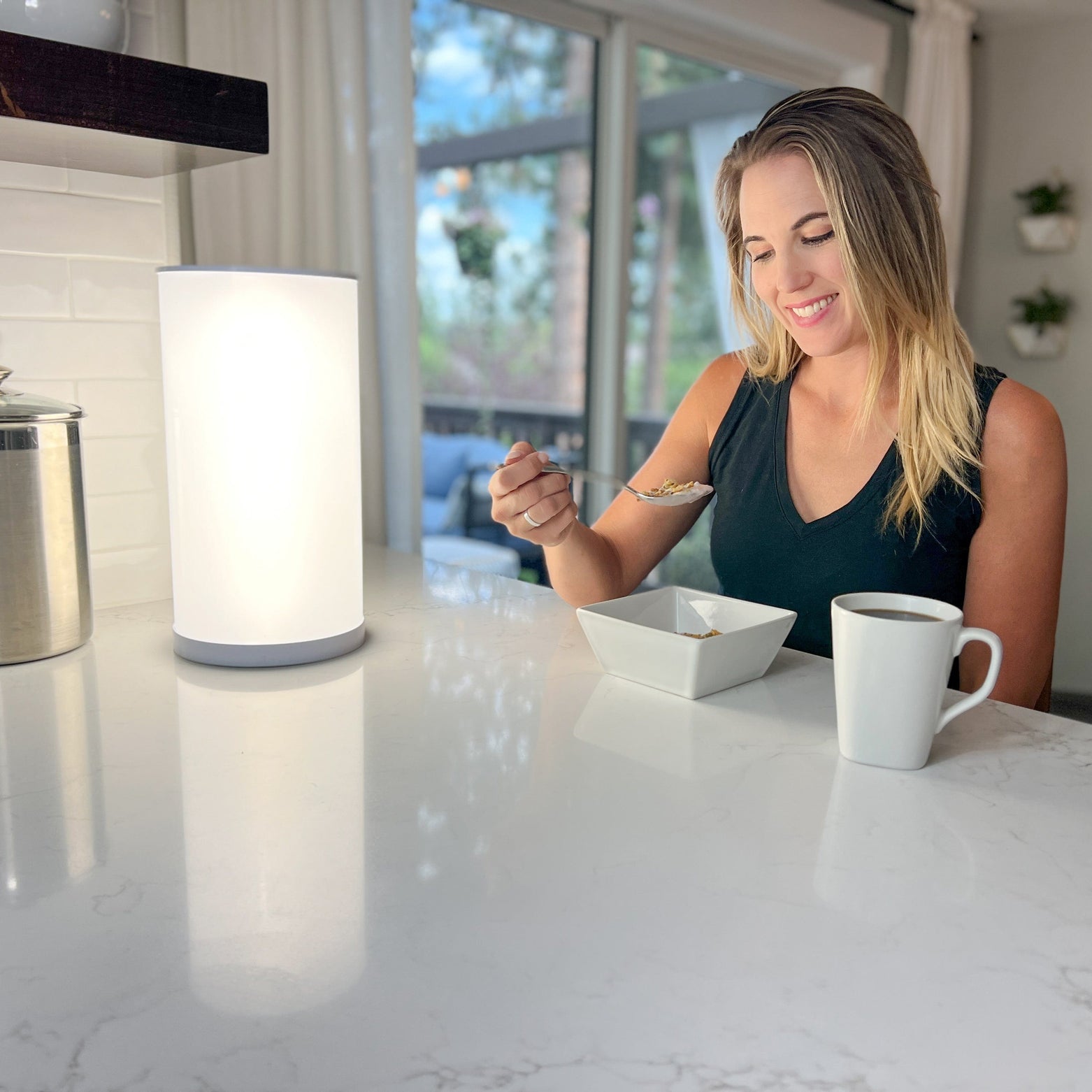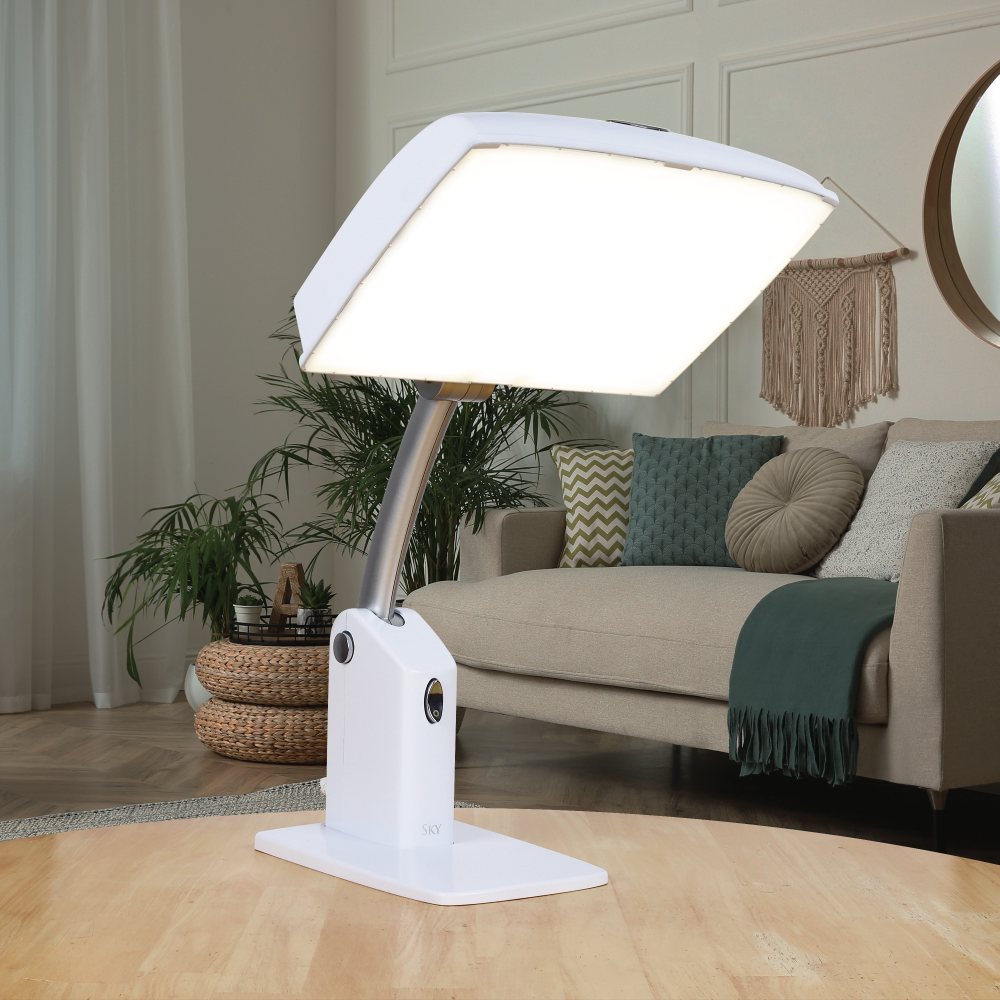Exposure to sunlight plays a role in the production of vital hormones, including melatonin and serotonin. Melatonin is important for regulating our sleep-wake cycle, which is known as our circadian rhythm. Serotonin helps regulate appetite, energy, sexual desire, and mood.
When your body does not get enough sunlight, the production of these hormones may be affected. Light therapy involves sitting in front of a bright light mimicking natural sunlight.
The amount of time you may need to sit in front of the light varies depending on its intensity. In most cases, sitting in front of a bright light for 20 to 30 minutes is sufficient to help treat conditions related to mood and sleep.
Bright light therapy helps regulate your hormone levels. The benefits can include the following:
- Improved mood
- Increased energy
- Treatment for light-related health conditions
- Better sleep
- Treatment for jet lag
One additional benefit of bright light therapy is it is a non-pharmacological treatment. It is not addictive and tends to be well tolerated by most people.
The American Psychiatric Association has recommended bright light therapy as a treatment for people with depressive disorder since 2005. According to an article published in the journal Psychiatric Research and Clinical Practice, a randomized trial found bright light therapy to be effective as an adjunct mood stabilizer for bipolar depression with a remission rate of 68% over 4 to 6 weeks. This is compared to a 22% remission rate with a dim red light placebo.
It is important to know how to choose a light box or light therapy lamp for optimal benefit. The article below provides a guide on what to look for in a light therapy lamp, including how to select the right lamp for your condition.
What to Look for in a Light Therapy Lamp
Not all light therapy lamps are made equally. When choosing a light therapy lamp, it's important to do your research to make sure it meets your needs. When choosing a light therapy lamp, consider the following key factors:
Your condition: The medical condition you are treating may play a role in the bright light lamp you choose. For example, if you are treating seasonal depression, you want a medical-grade lamp that puts out 10,000 LUX from 12” away for optimal treatment. Also, make sure it is rated as a SAD light therapy lamp. A health and wellness grade lamp may be sufficient if you are treating a minor condition, such as jet lag.
Light intensity (LUX): In bright light therapy, light intensity is measured in LUX. It is essential to get a lamp with a specific LUX for effective treatment for certain conditions. Research indicates a minimum LUX level of 10,000 for effective treatment for conditions such as seasonal depression.
For instance, an article published in the Journal of Psychiatry and Neuroscience found that sitting in front of a bright light lamp with 10,000 LUX for a half hour each morning was an effective treatment for seasonal affective disorder. According to the journal article most studies indicate that early morning treatment, before 8 am, is optimal. Light intensity less than 10,000 LUX may require a longer treatment time.
Circadian light (CLA): A relatively new measurement in bright light therapy is circadian light. Circadian light lamps emit a specific spectrum of light that mimics natural sunlight. Exposure to sunlight helps regulate the body's circadian rhythm. However, exposure to natural sunlight is not always possible. Circadian lights have shown to be effective in treating jet lag and certain sleep disorders.
Glare (LUX/in2): The glare from a light therapy lamp can be bothersome to some users. This may interfere with the amount of time they're willing to spend using the light. When the light intensity is bright, visual glare is possible from a light therapy lamp.
Choose a lamp with a low glare rating to minimize discomfort and eye strain. For example, select a light therapy lamp designed to alleviate visual glare.
Light spectrum ( color temperature): When selecting a bright light lamp for treatment of seasonal affective disorder, it is important to consider color temperature. Color temperature refers to the coolness or warmth of the light, which is measured in Kelvin (K). For example, warm light promotes calmness and has a comforting effect. Warm lights are around 1,000 k.
Cooler lights, typically between 5000 to 6500 K, promote alertness. This range mimics natural sunlight and is beneficial for people treating jet lag.
Medical grade vs health/wellness grade: There is a difference between medical-grade SAD lamps and health/wellness-grade lights. Understanding the differences can help you select the appropriate light for the condition you are treating.
- Medical-grade SAD lamps: This category of light therapy lamps usually directs light downward and produces 10,000 LUX from 12 inches away. They also tend to be larger than health and wellness-grade lamps. A medical-grade SAD lamp is intended to treat seasonal affective disorder and other mood conditions.
- Health / Wellness grade lights: These types of lights may have less light intensity, which would require sitting in front of the light longer. Health/wellness grade lights are generally intended to treat milder conditions, such as jet lag. However, one benefit is that they are usually smaller than medical-grade lamps, so they may be optimal for small spaces or if you need a portable option.
- Light angle: Light angle plays a role in treating your condition. It is helpful to select a downward facing lamp if you're treating a condition, such as seasonal depression. A downward facing lamp mimics direct downward light exposure from the sun. For instance, some lamps have a swivel feature, which lets you adjust the angle of the lights to meet your needs.
- Ultraviolet (UV) protection: One benefit of using a light therapy lamp or box is it does not expose you to ultraviolet light as the sunlight does. When selecting a light therapy lamp, ensure the lamp emits only visible light and does not contain harmful ultraviolet light rays.
- Safety certification: There is no one specific agency that certifies all medical grade light therapy lamps or boxes. However, choose lights that have certifications from reputable organizations, which ensure they've met quality standards and safety.
Additional Considerations
When deciding what to look for in a light therapy lamp, there are some additional considerations that may be helpful. Consider the following:
- Size and portability: Decide where you are going to place your light therapy lamp. Depending on the amount of space you have, you might need a smaller lamp. It's also important to decide whether you're going to keep the lamp in one space, or you want to be able to use it on the go and have it portable. There are quality lamps of all sizes including those that are portable.
- Timer and adjustability: A timer may be an important feature for some people. Having an automatic shut off and adjustable intensity settings makes using bright light therapy even easier.
- Ease of use: User friendly features, such as intuitive controls and touch screens, can make using bright light therapy even more convenient.
- Additional features: Some bright light therapy lamps have additional features, which some users may find beneficial. For example, some light have USB ports, alarm clocks, and wireless phone charging. Additionally, built-in blue light filters may be important to some users. When deciding what to look for in a bright therapy lamps, consider the additional features available and decide what's most important to you.
- Return policy and warranty: Hopefully, you will be happy with the bright light you select. But it is still important to make sure you understand the manufacturer’s return policy in case you are dissatisfied with the product. Also, select a light therapy lamp that offers a warranty so that you are protected in case there are any issues with the product.
Light Therapy Lamps vs Regular Lamps
A regular lamp does not produce the needed light intensity or color spectrum to treat conditions related to mood and sleep. It is a misconception to think you could swap a regular lamp for a light therapy lamp.
It's important to understand that a standard lamp is much different from a light therapy lamp. When it comes to light therapy lamps vs regular lamps there are several differences, such as the following:
- Light intensity: A regular lamp produces much lower LUX levels. Regular lamps may produce anywhere from 100 to 500 LUX. This level of light intensity is not enough to treat mood or sleep-related disorders. A light therapy lamp produces much higher LUX, so it has therapeutic benefits.
- Light spectrum: Regular lamps emit a wide range of colors on the light spectrum. This may include blue wavelengths. which can disrupt sleep. Light therapy lamps emit specific wavelengths of light that have mood boosting benefits.
Conclusion
A light therapy lamp can effectively treat various mood and sleep-related conditions, including seasonal affective disorder. When selecting a light therapy lamp, it's important to consider several factors, such as light intensity, light spectrum, glare, and whether you need a medical-grade light or a health and wellness light.
Although you can buy a light therapy lamp without a prescription from your doctor, it is best to consult a healthcare professional for guidance before purchasing a light. Everyone's situation is different. Taking certain supplements and having certain medical conditions may play a role in your exposure time and your general use of light therapy.








Leave a comment
All comments are moderated before being published.
This site is protected by hCaptcha and the hCaptcha Privacy Policy and Terms of Service apply.